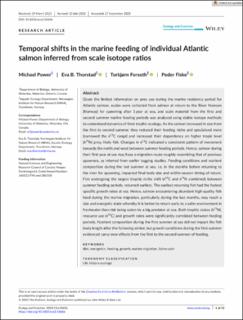| dc.contributor.author | Power, Michael | |
| dc.contributor.author | Thorstad, Eva Bonsak | |
| dc.contributor.author | Forseth, Torbjørn | |
| dc.contributor.author | Fiske, Peder | |
| dc.coverage.spatial | river Namsen, Norway | en_US |
| dc.date.accessioned | 2023-11-20T11:57:10Z | |
| dc.date.available | 2023-11-20T11:57:10Z | |
| dc.date.created | 2023-11-02T14:36:17Z | |
| dc.date.issued | 2023 | |
| dc.identifier.issn | 2045-7758 | |
| dc.identifier.uri | https://hdl.handle.net/11250/3103557 | |
| dc.description.abstract | Given the limited information on prey use during the marine residency period for Atlantic salmon, scales were collected from salmon at return to the River Namsen (Norway) for spawning after 1 year at sea, and scale material from the first and second summer marine feeding periods was analysed using stable isotope methods to understand dynamics of their trophic ecology. As the salmon increased in size from the first to second summer, they reduced their feeding niche and specialised more (narrowed the δ13C range) and increased their dependency on higher tropic level (δ15N) prey, likely fish. Changes in δ13C indicated a consistent pattern of movement towards the north and west between summer feeding periods. Hence, salmon during their first year at sea may have a migration route roughly resembling that of previous spawners, as inferred from earlier tagging studies. Feeding conditions and nutrient composition during the last summer at sea, i.e. in the months before returning to the river for spawning, impacted final body size and within-season timing of return. Fish undergoing the largest trophic niche shift (δ13C and δ15N combined) between summer feeding periods, returned earliest. The earliest returning fish had the fastest specific growth rates at sea. Hence, salmon encountering abundant high-quality fish food during the marine migration, particularly during the last months, may reach a size and energetic state whereby it is better to return early to a safer environment in freshwater than risk being eaten by a big predator at sea. Both trophic status (δ15N), resource use (δ13C) and growth rates were significantly correlated between feeding periods. Nutrient composition during the first summer at sea did not impact the fish body length after the following winter, but growth conditions during the first summer evidenced carry-over effects from the first to the second summer of feeding. diet, energetics, feeding, growth, marine migration, Salmo salar Life history ecology | en_US |
| dc.description.abstract | Temporal shifts in the marine feeding of individual Atlantic salmon inferred from scale isotope ratios | en_US |
| dc.language.iso | eng | en_US |
| dc.rights | Navngivelse 4.0 Internasjonal | * |
| dc.rights.uri | http://creativecommons.org/licenses/by/4.0/deed.no | * |
| dc.subject | diet | en_US |
| dc.subject | energetics | en_US |
| dc.subject | marine migration | en_US |
| dc.subject | Salmo salar | en_US |
| dc.subject | Life history ecology | en_US |
| dc.subject | feeding | en_US |
| dc.subject | growth | en_US |
| dc.title | Temporal shifts in the marine feeding of individual Atlantic salmon inferred from scale isotope ratios | en_US |
| dc.title.alternative | Temporal shifts in the marine feeding of individual Atlantic salmon inferred from scale isotope ratios | en_US |
| dc.type | Peer reviewed | en_US |
| dc.type | Journal article | en_US |
| dc.description.version | publishedVersion | en_US |
| dc.rights.holder | © 2023 The Authors | en_US |
| dc.subject.nsi | VDP::Zoologiske og botaniske fag: 480 | en_US |
| dc.subject.nsi | VDP::Zoology and botany: 480 | en_US |
| dc.source.volume | 13 | en_US |
| dc.source.journal | Ecology and Evolution | en_US |
| dc.source.issue | 1 | en_US |
| dc.identifier.doi | 10.1002/ece3.10656 | |
| dc.identifier.cristin | 2191524 | |
| dc.relation.project | Norges forskningsråd: 160022 | en_US |
| dc.relation.project | Norges forskningsråd: 280308 | en_US |
| dc.relation.project | Andre: Natural Sciences and Engineering Research Council of Canada | en_US |
| dc.source.articlenumber | e10656 | en_US |
| cristin.ispublished | true | |
| cristin.fulltext | original | |
| cristin.qualitycode | 1 | |

